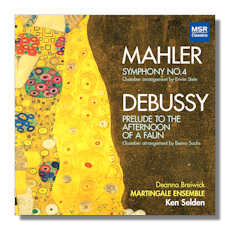
The Internet's Premier Classical Music Source
Related Links
-
Mahler Reviews
Debussy Reviews - Latest Reviews
- More Reviews
-
By Composer
-
Collections
DVD & Blu-ray
Books
Concert Reviews
Articles/Interviews
Software
Audio
Search Amazon
Recommended Links
Site News
 CD Review
CD Review
Chamber Arrangements

- Gustav Mahler: Symphony #4 in G (arr. Stein)
- Claude Debussy: Prelude to the Afternoon of a Faun (arr. Sachs)
Deanna Breiwick, soprano
Martingale Ensemble/Ken Selden
MSR Classics MSR1373 63:35
Summary for the Busy Executive: More from the Schoenberg circle.
Just after World War I, Schoenberg initiated an extraordinary series of concerts of recent and contemporary music for a private-subscriber society (actually there were two incarnations of this). Apparently everyone but music critics could attend. In truth, however, a couple did make it under special indulgence, but they had to promise not to review what they heard. The society offered well-rehearsed, well-played accounts. Since much of the music was orchestral and since the society couldn't afford a large group, the works appeared in chamber versions, usually carried out by Schoenberg or his pupils. Schoenberg's arrangements astonish by their ability to keep the basic colors of the originals with severely reduced forces, usually a string quartet, double bass, wind quartet, percussion, piano, and harmonium. This disc is one of two in what I hope will turn out to be a series. The first disc featured Mahler's Das Lied von der Erde in Schoenberg's extraordinary arrangement (MSR MS1406). This disc presents work by Benno Sachs as well as by Schoenberg's pupil Erwin Stein.
The Mahler Symphony #4 was a mere twenty years old when Stein made his arrangement in 1921, and it still had the feel of difficult modern music. It strikes me that this symphony, Mahler's most intimate, probably made the best candidate for a chamber version. However, the Stein translation gave me a few problems at first. It didn't sound particularly convincing as a chamber piece and its reduced forces made it even less so as a symphony, particularly at the transition between the third movement and the last, which needs a bit more noise at the outset. The score inhabited an uncomfortable middle place. Nevertheless, as I continued to listen, both objections mattered less and less. Furthermore, that Stein got so much of the original into such a small space amazes me. The reduced forces make clear Mahler's solid basis in and mastery of counterpoint. The subsidiary voices are usually composed rather than borrowed or mere harmonic filler. I hear lines in this version, I've never heard before, especially in the first movement, even in accounts of exceptional orchestral clarity. Stein also makes the kaleidoscopic shifts in Mahler's orchestral colors clearer than in a full orchestra, mostly due to the absence of a covering blur from a large body of strings. You get to see the bones beneath the flesh.
Benno Sachs does in a quiet way a spectacular job with Debussy. Of course, the Prelude succeeds in the composer's own arrangement for two pianos only, demonstrating the soundness of his basic composition in black-and-white or in color. Sachs shows you how much of that color depends on solo winds. The blend Sachs achieves is also gorgeous.
As impressive as the arrangements may be, the performances equal them. I think Selden and the Martingale have produced one of the better Mahler 4s and one of the most sensuous Preludes on record (take that, Fifty Shades of Gray!). The playing is flat-out gorgeous, both in the solos and in the ensemble. The control over phrasing and dynamics makes me gasp, all the while sounding like the most natural thing in the world. I can't recommend this disc highly enough for its willingness to explore and for its realization. The sound is excellent. I want to encourage Selden and MSR to bring out a complete series of this corner of the repertory.
Copyright © 2015, Steve Schwartz




















